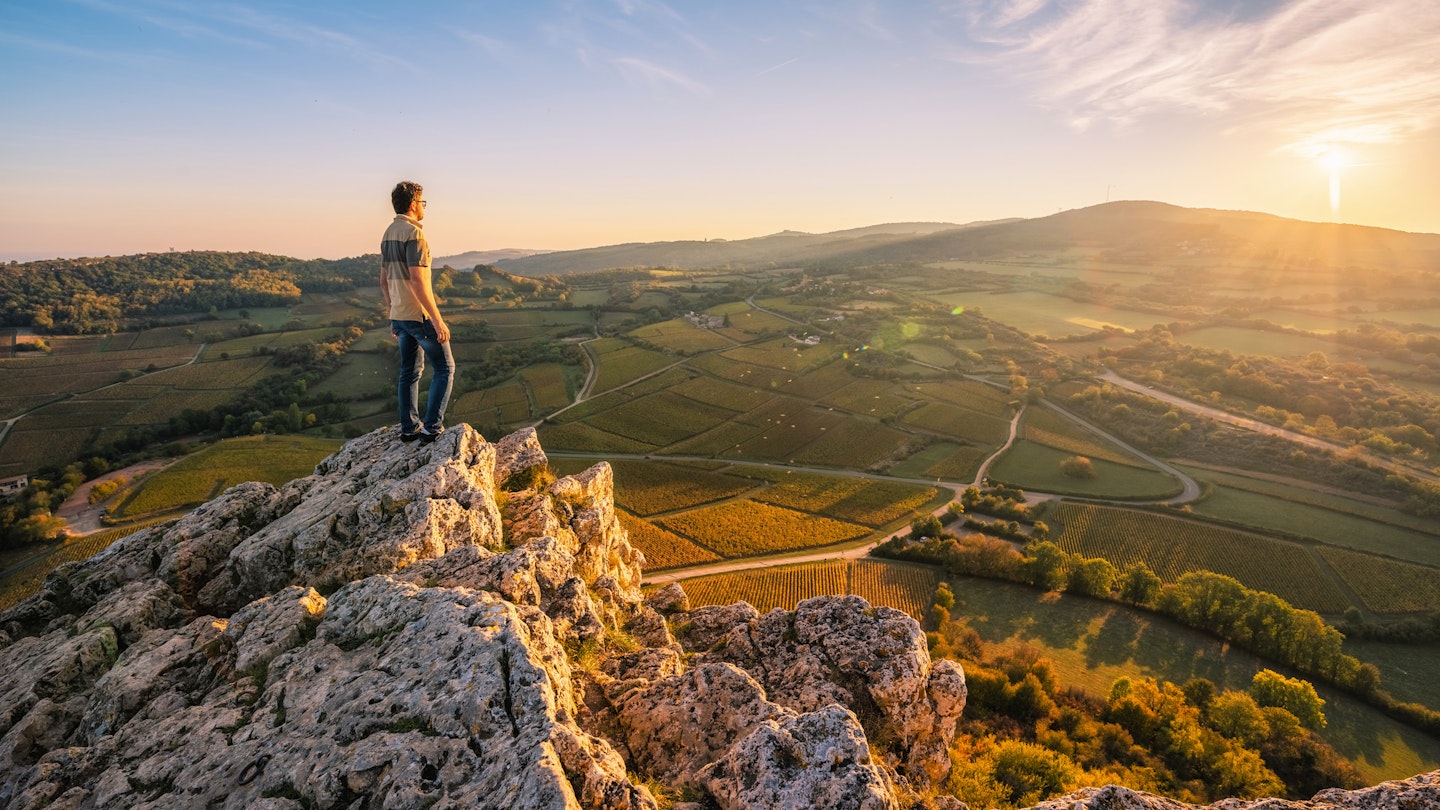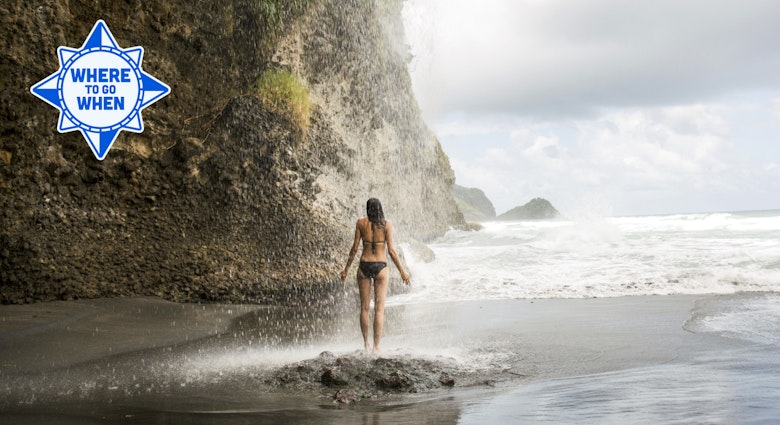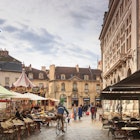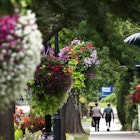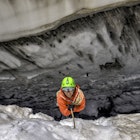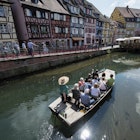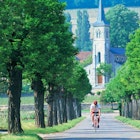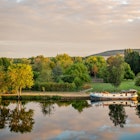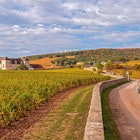With a smorgasbord of gorgeous villages, a dashing medieval-turned-Renaissance capital and more chateaux-crowned vineyards than you could ever hope to visit in a lifetime, France’s premier wine region comes loaded with priceless French panache.
But with a bottle of the best Bourgogne red demanding a price tag of several zeros, is it actually possible to share in Burgundy’s wine-fueled joie de vivre without spending a single cent? With savvy planning and on-the-ground intel, it is. Here’s how.
Get acquainted with Burgundian climats
Given Burgundy’s gargantuan wine heritage, first-time visitors would do well to make Beaune their first stop. The unofficial capital of the hallowed Côte d’Or, Beaune itself is a gorgeous town to amble with its rampart-encircled old city, splendiferous medieval charity hospital (those gargoyles and dazzling tile roof!) and quaint cobbled lanes hiding a subterranean labyrinth of cellars stashed with priceless vin. Free films and bilingual displays at its fascinating Maison des Climats deep-dive into the history, culture and viticulture traditions of Burgundy’s iconic climats or wine-growing plots, a Unesco World Heritage site since 2015.

Swirl, sniff, sip and spit wine
A precise, if unspoken, etiquette surrounds dégustation (wine tasting). Generally speaking, only embark on a wine tasting spree if you intend purchasing a couple of bottles afterwards. This said, there is no obligation to buy.
Larger wineries like Patriarche Père et Fils, where more than 2 million bottles age in vaulted 13th-century wine cellars stretching underground for 5km, charge a token admission fee of around €18 – good-value given it includes a guided tour, tasting of six to 10 different wines and free tastevin (tasting glass). Tastings at smaller chateaux, like Château Corton C with female oenologist Caroline Frey at the helm of organic vineyards carpeting slopes around the tiny village of Aloxe-Corton, are more intimate and offerte (offered, aka free).
Hit the Grand Crus road
Hit the wine road with Balades en Bourgogne, a free app by the Côte d’Or tourist board mapping 160 walking, cycling, mountain-biking and driving itineraries around the prestigious wine-growing region. Audio histories are included in the phone-smart mix (iPhone and Android), searchable by theme and transport mode.
Burgundy’s Champs-Elysées of wine-themed itineraries is the Route des Grand Crus. Here, motorists have cruised along some 37 miles (60km) of quiet country lanes, through soft undulating hills carpeted in pea-green vines and 38 chateau-stitched wine-making villages between Dijon (north) and Santenay (south) since 1937. Cycling and walking paths have since been added to the picturesque trail and promise an equally exhilarating ride.
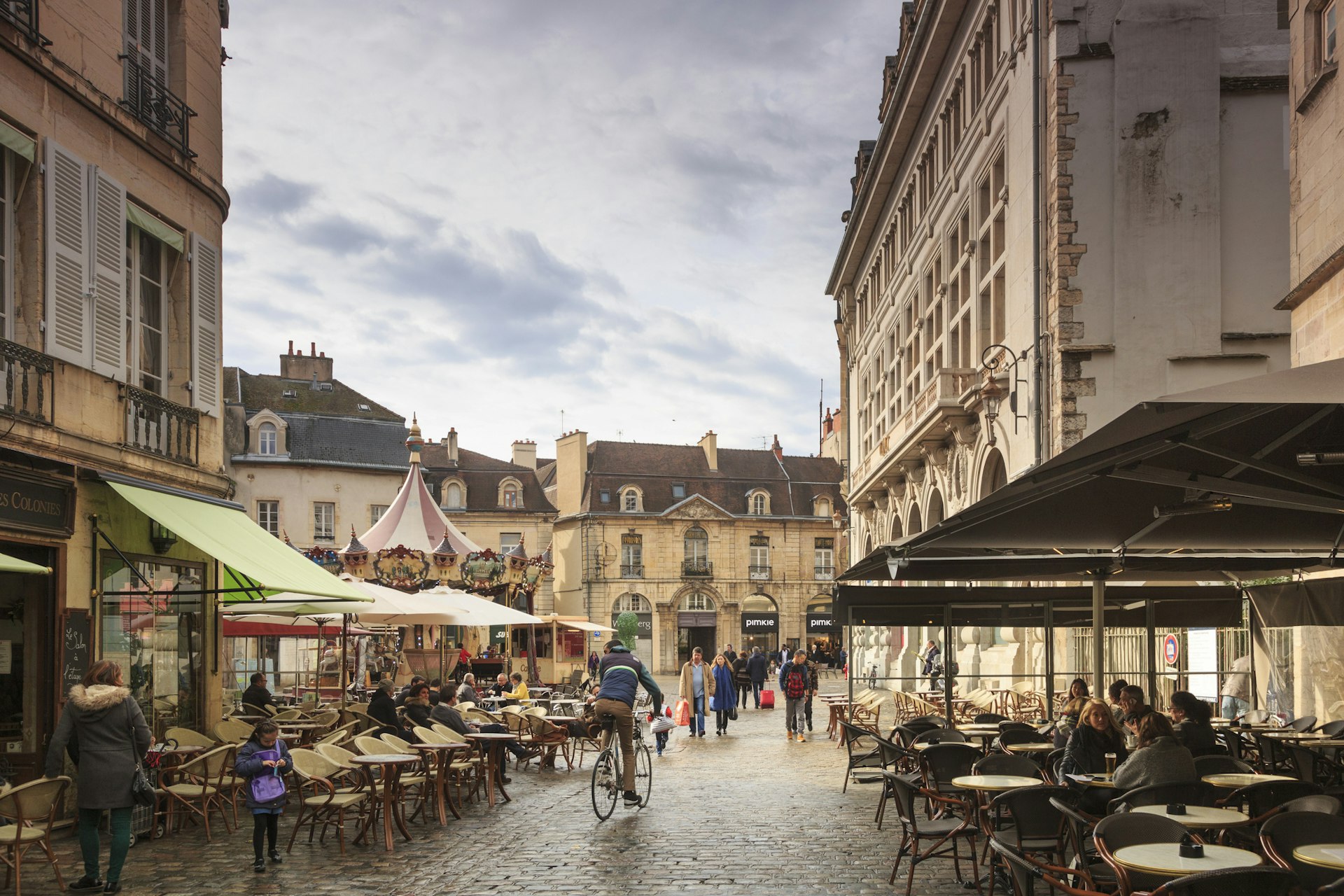
Soak up Dijon’s artistic glory
Thanks to the powerful dukes of Burgundy, the regional capital is blessed with an overdose of medieval and Renaissance buildings, many with dazzling polychrome tile roof or ornate sculpted facades (don’t miss the Maison des Cariatides and leering gargoyles and chiming clock at Église Notre Dame). Most hark back to Dijon’s 14th- and 15th-century heyday, evoked in a delightful collection of municipal museums – all free. The eastern wing of the dukes’ original palace houses the Musée des Beaux Arts, one of France’s best fine-arts museums. Traditional Burgundian life is the focus of the Musée de la Vie Bourguigonne, in a 17th-century convent. Celtic, Gallo-Roman and Merovingian artefacts fill the Musée Archéologique.
Eternal happiness and wisdom is freely available on tap – or rather with a gentle caress of the exceedingly-well-rubbed stone owl carved into the exterior corner of a chapel across from No 24 on rue de la Chouette – so local lore claims.
Kid around in a Dijon fountain
Kidding around in the water-jet fountains on Place de la Libération, laid out in 1686, is the only way to cool off in summer. Shooting up out of the ground in bursts, the water jets are an irresistible warm-season draw and bags of fun after dark when they are illuminated. Grab a pew on a café pavement terrace ringing the square for a glass of wine and inspirational views of the neoclassical ducal palace, while happy kids run wet ‘n wild.
Run (or swim) wild on Black Mountain
Outdoor enthusiasts run wild in the Morvan (meaning ‘Black Mountain’ in Celtic), a 700-sq-km protected area of dense woodland, lakes and rolling farmland. On dry land choose from 1550 miles (2500km) of walking trails, mountain biking, horse riding and rock climbing. Or take your pick of several artificial lakes and four rivers. Cold-water swimmers can take the plunge at Lac des Settons and Lac de Saint-Agnan.
Travel to ancient Gaul
Burgundy promises a compelling trip through pre-Roman France. The Celtic spirit is alive and well in Bibracte, an ancient Gaul stronghold where Vercingétorix was crowned Gaullish chief in 52 BCE. The on-site museum commands an entrance fee, but the free expansive views from the mountaintop site and walking trails – including a fantastic 3-mile (5.2km) circular loop around the ancient Gallic fortification – on the surrounding archaeological site easily warrant a trip here. Download the free La Boussole app to uncover, in situ, archaeological remains hidden beneath your feet.
Several natural springs were sacred to the Celts. Pay your respects at the gushing, vivid blue-green torrent of Fosse Dionne in Tonnere or the 600L-per-second artesian spring spouting from a cliff at Source de la Douix in Châtillon-sur-Seine. A picnic is always a good idea.
Track a WWII Resistance fighter
Few ‘museums’ evoke the bravery, endurance and grueling daily life of French Resistance fighters during WWII as powerfully as the Chemins de Mémoire in the Parc Naturel Régional du Morvan. Twenty-one memorial sites linked by walking trails commemorate the guerrilla-fighter Resistance who sought refuge in vast swathes of forest and maquis (scrub) here in 1943 and 1944. Download a site map or grab one at the Musée de la Résistance in St-Brisson and create your own history lesson on foot or bicycle.

Find village enchantment in Yonne
Roughly midway between Dijon and Paris, the Yonne département is Burgundy's northern gateway and treats visitors to verdant countryside peppered with enchanting villages. Watching the sun peek over medieval battlements or strolling cobbled streets laced with Instagram-loved, 15th- and 16th-century gabled houses in the magical, multi-turreted walled village of Noyers-sur-Serein, 30km south of the ancient river port of Auxerre, doesn’t cost a cent. Ditto for an atmospheric ramble around the Unesco World Heritage-listed hilltop village of Vézelay, crowned by an architectural gem of a medieval basilica and framed by a sublime patchwork of vineyards, sunflower fields and cow pastures.
Celebrate with locals at a wine festival
As with every French region, festivals are plentiful in Burgundy and invariably cook up a brilliant opportunity to eat and drink with locals, often for free or for very little. The first big fest of the year celebrates Saint Vincent, the patron saint of vignerons (winemakers) with street processions, mass, wine tastings and two days of wine-fueled merriment over the last weekend in January. A different village hosts Saint Vincent Tournante each year, celebrated since 1938.
Another fantastic freebie is the Festival Musical des Grands Crus de Bourgogne, which raises the curtain on dozens of musical concerts and gigs, including alfresco in vineyards, from July to early October. The theme is always the same: wine.
Safety recommendations and restrictions during a pandemic can change rapidly. Lonely Planet recommends that travelers always check with local authorities for up-to-date guidance before traveling during Covid-19.
You might also like:
France’s 10 most stunning road trips
France’s 10 best natural wonders
First-time France: where to go and what to do

